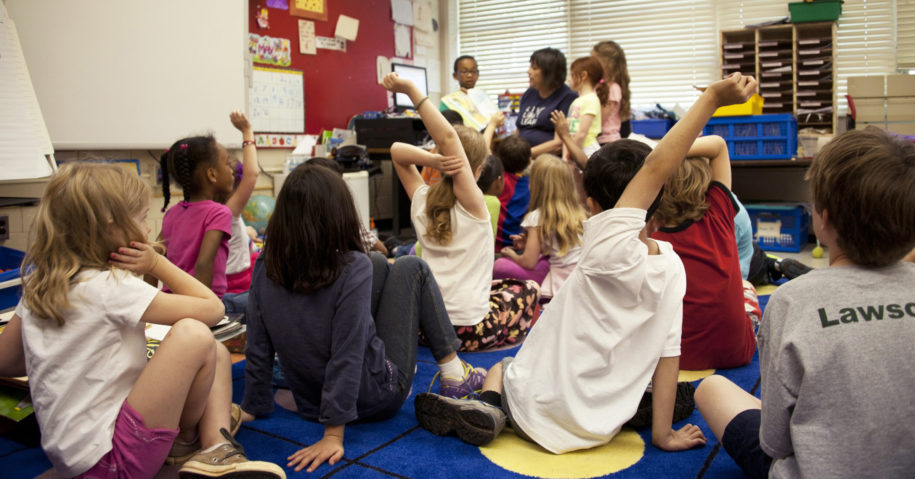Support Educators and Help Students Thrive as They Go Back To School
2020 was uncharted territory for the American education system. The rapid spread of COVID-19 shuttered schools in spring last year, shifting education to remote learning and socially distanced classrooms. In this chaotic time, educators bear the brunt of increased mental stress in trying to perform their job. “The majority of teachers reported that they feel ‘somewhat’ or ‘extremely’ uncertain (81 percent), stressed (77 percent), [or] anxious (75 percent),” with 43% of them feeling their students would not be able to fully adjust to virtual classrooms. A similar stress was placed on parents, who suddenly found themselves more crucial to the education process.
However, as national vaccination kicked in and new Covid cases began to fall, many were hopeful for a return to normalcy in the classroom. Yet, the new Delta variant of Coronavirus – coupled with children under 12’s inaccessibility to receive the vaccine – has put those plans into question. As the drop head to an article from Bloomberg perfectly surmises; “Confusing mask rules. Spooked parents. Changing CDC guidelines. And class hasn’t even started yet.”
Covid has acted like a magnifying glass to our school system, stress testing our schools and displaying the innate issues which have plagued our education system. While it is important to support educators and students for the unique challenges which the pandemic has brought, we must also not lose sight of the problems which were affecting the country’s students before Covid. As students and teachers get ready to get back to school, find out how you can support educators and help students thrive.
Support Educators

Globally, the United States is ranked 7th in terms of average teacher salary, with the national average hovering just below $60,000. Despite this fact, most teachers report spending at least $500 of their own money on classroom supplies. As teachers prepare for students to come back to school, this number will only balloon to supply adequate PPE for themselves and their students. This is emblematic of a large issue facing educators: they are expected to give so much without additional resources or payment.
While Americans as a whole work just under 35 hours a week, the 40 hour week is the standard for most industries. In theory, this is how much teachers should work a day, yet their days often far exceed this and cut into evenings and weekends. In fact, one study found 1 in 4 teachers work 60 hour a week, and 1 in 10 work over 65 hours a week.
This overworking of teachers, along with salaries that do not reflect the amount of time worked outside of the classroom, has led to a surprisingly high teacher turnover and burnout rate. Every year, 8% of teachers leave the profession, and 9 out of 10 teachers hired each year are replacing colleagues who left voluntarily. However, why is teacher workload so exorbitant, even before the age of COVID-19?
As a blog from Room to Discover puts simply, “we expect more from teachers than we used to.” Our expectations of the roles of educators have ballooned exponentially, as teachers “are [now] expected to meet each student’s unique academic and social-emotional needs. Make learning exciting. Analyze data. Integrate technology. The list goes on.” While students benefit greatly from these services, we are asking more and more of our teachers while not providing them additional resources.
To assist our teachers and give them all the tools they need to shape the next generation, they are in need of three types of support. The first is staff support, meaning teachers need personnel like psychologists, learning specialists, and aides to help cater to each students’ emotional and academic needs. Second, teachers need ample material sources like technology and classroom materials. This is where most teachers end up spending their own time and money procuring. Lastly, educators need cooperation and support from the community and parents.
As a society we must elevate teachers, viewing their career as essential to the development of children’s minds and talents. If we begin to address these needs – even on a small level – we can give our educators more time and energy to do what they love to do; not only benefiting them but our children as well.
Give Students Resources to Thrive

The COVID-19 pandemic did not just add stress to overworked parents and teachers, but unearthed much deeper issues in our education – and by extension, childcare – system. As soon as school doors were shuttered, it quickly became apparent that many children were dependent on the services their schools provided them. One of the most pressing issues being food.
Every summer, millions of children experience food insecurity by not receiving daily meals at school. With the pandemic closing schools and putting millions out of work, this issue has become an epidemic. Summer (and Covid-related) food programs, such as No Kid Hungry, are currently feeding millions of children, yet these programs always need more support. For our kids to be able to do their best in school and life, they need their basic human needs met. Food is one of the most important, assisting mental, emotional and psychical growth.
However, hunger is not the only issue which affects the success of students. Even before the pandemic, technology like personal computers and internet access were an essential part of school work. From writing and researching papers to turning in homework, technology is quickly becoming intertwined with the education process, yet many students do not have ample access to these resources. This was intensified as school and public libraries closed, leaving many children with very few options for completing their school work. Whether through school districts or nonprofits, providing technology to kids in need is essential for success in the education system.
Another often overlooked resource which children thrive off are well funded arts and athletic programs. Studies have found that these programs elevate students on multiple levels, helping them thrive socially and educationally. Most commonly known, involvement in arts and athletics programs noticeably raises proficiency in all core subjects (math, science, english and social studies). Yet, these programs create a positive effect on a deeper level with students. It has been found that athletic and art programs raise self-esteem, build emotional intelligence, and even lower the rates of disciplinary infractions.
Going Back to School

Public education usually ranks among Americans’ most pressing issues. Yet, little for mass scale overhauling of the education system has been done in our country over the last few decades. From economic and geographic privilege to teachers’ workload and childhood hunger, addressing the innate problems within our education system means addressing all the social and economic issues which surround it. This may be a tall order, but it is very achievable.
Every student has the ability to thrive and get the most out of their education, they just need the resources and support. With adequate staff, access to basic human needs, ample technological support, and forums to express themselves and have fun, every student can find school rewarding and fruitful. By addressing these issues within and surrounding the educational system, we can give students all the tools they need to succeed in school, the workplace, and life.
There are many ways we can make education fruitful for our children and young adults. Even small gestures can completely alter the life of a burgeoning mind. To find ways you as an individual can make an impact on our education system, check out Impactree’s Education Action Page.


